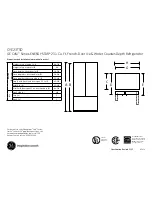
16
PHOTOVOLTAIC CONTROLLER
INFORMATION
When using Lead-Acid batteries in photovoltaic systems it is important to protect
them against overcharging which would otherwise cause excessive gassing and
overheating, resulting in permanent plate damage and loss of electrolyte. The
Photovoltaic Controller is installed into the system to perform this task. Over –charge
prevention is achieved by limiting the battery voltage to a maximum of around 2.3
Volts per cel at 25
0
c.This cause the charging current to fall naturally before gassing
becomes a problem. The battery can be left charging at this ‘float’ voltage for long
periods with minimal electrolyte loss. A periodic equalization charge is given to avoid
plate sulphation and electrolyte stratification. The battery float voltage is temperature
compensated. In order to measure temperature, a temperature sensor is built in to
the controller. The controller should therefore be mounted as close as possible to the
batteries.
The controller also has an automatic low voltage disconnect facility. In the event of
the batteries not receiving charge, the refrigerator will be disconnected before
permanent battery damage occurs, thus protecting system. Re-connection is
automatic. A Liquid Crystal Display (LCD) indicates the state of charge of the
batteries, and terminals are provided for the connection of batteries, photovoltaic
panels and the refrigerator.
OPERATION
The Photovoltaic Controller is fully automatic in operation. See Steca manual for
installation.
REGULAR FUNCTIONS
The display widow on front panel shows system and error message, the left button
on front panel can be used to switch display windows or calling up settings and the
right button is used as a manual load switch, or confirmation button in the
programme mode. The three displays, which are the most relevant to the operation
of the refrigerator, are as follows:
1. CORRECT OPERATION:
Indicated by a smiling face in the display window. A sad
face indicates a fault. The reference number in the display can then be looked up in
the manual to give the meaning of the error and the cause/remedy.
2. STATE OF CHARGE:
Indicated by the bar graph (SOC) and a percentage on the
display. When the state of charge is 50% or less, icepacks should not be frozen.
3. LOAD DISCONNECTION:
The refrigerator is disconnected when the state of
charge drop to 30%. The SOC bar value, or the voltage value, flashes. The face
looks sad until the reconnection set point is reached.
THE LCD ALSO PERFORMS VARIOUS OTHER FUNCTIONS. CONSULT THE
MANUFACTURER’S HANDBOOK FOR FURTHER INFORMATION.
Summary of Contents for VC150
Page 1: ......
Page 3: ...3 SECTION I ...
Page 4: ...4 ...
Page 24: ...24 MODULE AND BATTERY WIRING DIAGRAMS SYSTEM WIRING DIAGRAM ...
Page 25: ...25 SYSTEM WIRING DIAGRAM GENERAL LAYOUT DIAGRAM ...
Page 26: ...26 GENERAL LAYOUT DIAGRAM ELECTRICAL CIRCUIT DIAGRAM ...
Page 27: ...27 ELECTRICAL CIRCUIT DIAGRAM REFRIGERATION CIRCUIT DIAGRAM ...
Page 28: ...28 REFRIGERATION CIRCUIT DIAGRAM ...
Page 29: ...29 SECTION II ...
Page 38: ...38 ...
Page 39: ...39 ...
Page 42: ...42 ...
Page 44: ...44 ...
Page 50: ...50 ...
Page 124: ...124 ANNEX 1 COMPONENT LAYOUTS OF SOME COMMONLY USED SOLAR REFRIGERATOR ...
Page 125: ...125 ...
Page 126: ...126 ...
Page 127: ...127 ...
Page 128: ...128 ...
Page 129: ...129 ...
Page 130: ...130 ANNEX II ADDITIONAL EPI TOOL KIT NEEDED FOR PHOTOVOLTAIC REFRIGERATOR REPAIR ...
Page 136: ...136 ...
Page 137: ...137 ...
















































